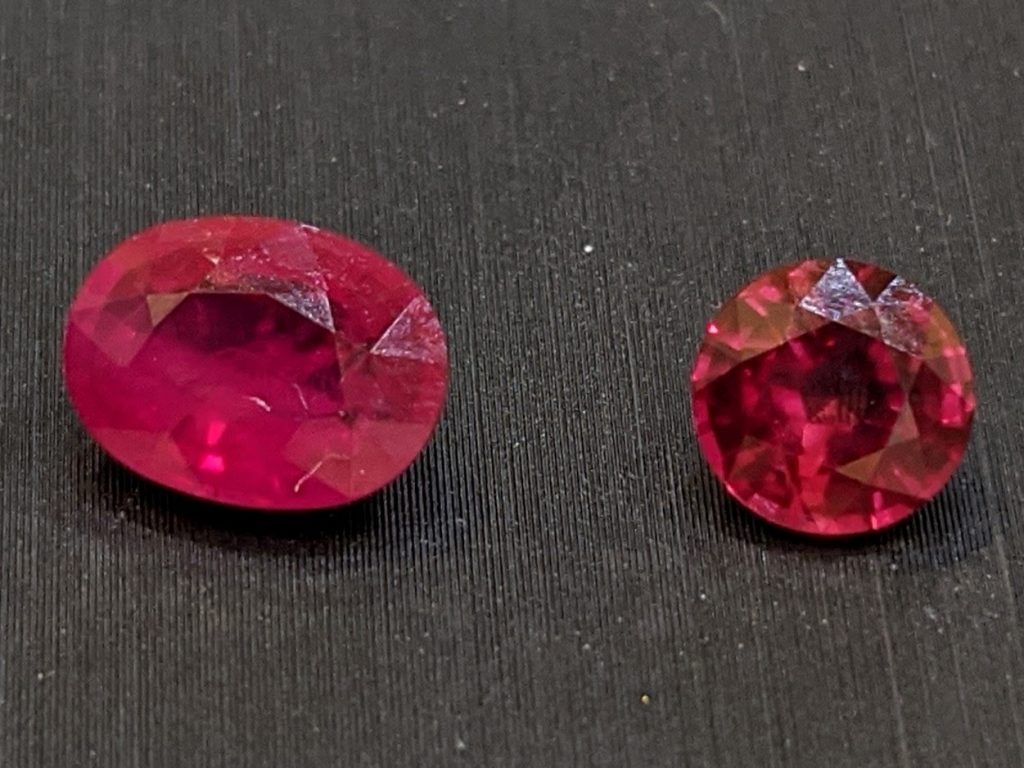Why Rubies are Expensive
When forming in nature, there are a number of complications to the process of ruby growth. The first one is that the mineral species of corundum only form in a low-silica environment. The same silica that is the second most abundant element in the earth’s crust.
Corundum also needs a low-iron environment, with iron being the fourth most abundant element on earth. This requirement is not as strict as the silica since iron does color yellow sapphires, blue sapphires too when titanium is present, but needs to be in trace amounts only.

When looking at rubies, even small amounts of iron are very visible. If there is too much, you will get an orange sapphire instead of a ruby. Iron also inhibits the fluorescence of chromium , the trace element that makes rubies red. Just looking at Burmese and Mozambique rubies without UV light, the difference is clear.
The ruby on the left was formed in the marble Myanmar (The country was formerly known as Burma, though most people still know it by the former name) deposits, while the ruby on the right was formed in Mozambique basalt deposits. Basalt has a higher iron content than marble, so the ruby has a higher iron content too.
Complications of Chromium

Despite only being a trace element in rubies, the chromium causes other complications. The element does not mix as well with corundum as other coloring elements like the iron and titanium in blue sapphires. Sapphires have reached absolutely monstrous sizes of over 500 carats, like the Star of India . There is also the Sapphire of Queen Marie that weighs over 470 carats.
Here is Queen Marie of Romania in one of her many portraits, along with that huge sapphire named after her hanging at the bottom of the pendant. Much like the visible pearls, the sapphires in her crown are huge. However, the one hanging as the pendant is twice the size of the largest sapphire in the crown.
There are larger rubies, with the largest ruby ever cut being the Liberty Bell Ruby below. However, it was carving-grade and opaque unlike the Sapphire of Queen Marie.

Lack of transparency aside in the Liberty Bell Ruby, it also has a small amount of purple coloring the red. This is very common in rubies, and usually means there are traces of iron and titanium present (the same stuff that makes sapphires blue). This is part of the reason why a low-iron environment is very important for rubies.

The largest fine-quality ruby is the Hope Ruby below, weighing 32 carats. It sold for a whopping $6.7 million USD at auction.
The Hope Ruby is not even a tenth of the size of these massive sapphires, illustrating the growth limitation. Moreover, it is not the most expensive ruby either, with that title going to the Sunrise Ruby at $30 million USD.
Complications with Crystallization

Another issue with ruby size is its natural habit, the shape the ruby crystals like to grow in. Rough, uncut ruby crystals like to form flat, hexagonal tablets. As illustrated with the Liberty Bell, carving grade rubies can grow in much larger shapes. It most likely formed in a shape like R2005 below, which is more like the sapphire habit (tall and hexagonal).

Ruby ID Left: R2005 – Weight: 7453.44 carats or 3.29 pounds – Origin: Sri Lanka formerly Ceylon
In short, rubies form in a rare environment with numerous other elements in trace amounts creating inclusions. Furthermore, it takes even less of these elements to alter the red color of chromium to purple or orange. Even when they do form, the natural habit of rubies is to grow in a way that prevents them from being cut in larger carat sizes.
All these factors combined, it’s something of a miracle to find rubies clear enough to facet over a full carat in size.
